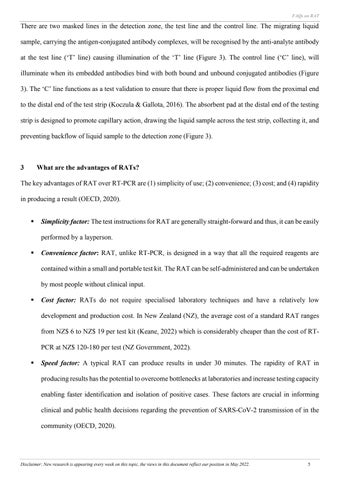FAQs on RAT
There are two masked lines in the detection zone, the test line and the control line. The migrating liquid sample, carrying the antigen-conjugated antibody complexes, will be recognised by the anti-analyte antibody at the test line (‘T’ line) causing illumination of the ‘T’ line (Figure 3). The control line (‘C’ line), will illuminate when its embedded antibodies bind with both bound and unbound conjugated antibodies (Figure 3). The ‘C’ line functions as a test validation to ensure that there is proper liquid flow from the proximal end to the distal end of the test strip (Koczula & Gallota, 2016). The absorbent pad at the distal end of the testing strip is designed to promote capillary action, drawing the liquid sample across the test strip, collecting it, and preventing backflow of liquid sample to the detection zone (Figure 3).
3
What are the advantages of RATs?
The key advantages of RAT over RT-PCR are (1) simplicity of use; (2) convenience; (3) cost; and (4) rapidity in producing a result (OECD, 2020). ▪
Simplicity factor: The test instructions for RAT are generally straight-forward and thus, it can be easily performed by a layperson.
▪
Convenience factor: RAT, unlike RT-PCR, is designed in a way that all the required reagents are contained within a small and portable test kit. The RAT can be self-administered and can be undertaken by most people without clinical input.
▪
Cost factor: RATs do not require specialised laboratory techniques and have a relatively low development and production cost. In New Zealand (NZ), the average cost of a standard RAT ranges from NZ$ 6 to NZ$ 19 per test kit (Keane, 2022) which is considerably cheaper than the cost of RTPCR at NZ$ 120-180 per test (NZ Government, 2022).
▪
Speed factor: A typical RAT can produce results in under 30 minutes. The rapidity of RAT in producing results has the potential to overcome bottlenecks at laboratories and increase testing capacity enabling faster identification and isolation of positive cases. These factors are crucial in informing clinical and public health decisions regarding the prevention of SARS-CoV-2 transmission of in the community (OECD, 2020).
Disclaimer: New research is appearing every week on this topic, the views in this document reflect our position in May 2022.
5

